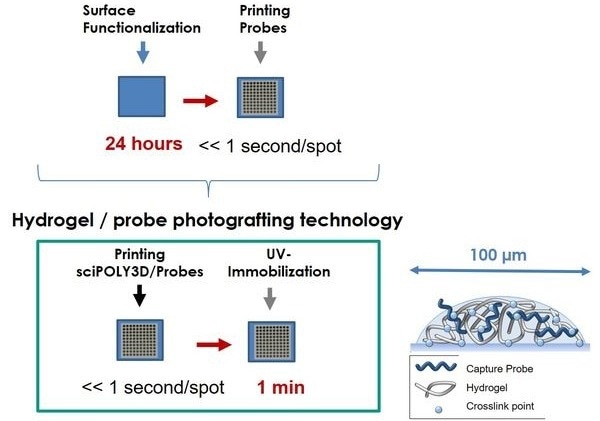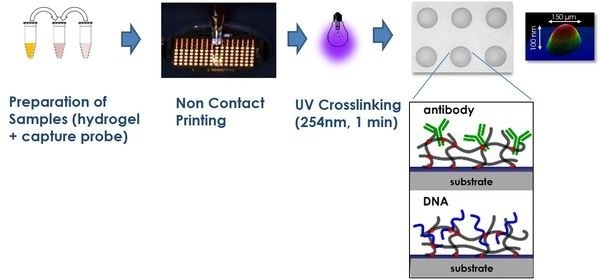Overview
Biomolecules can be immobilized using sciPOLY3D on the majority of polymeric substrates without the need for functional groups on the surface or within the biomolecule. Additionally, it permits covalent immobilization on protein-repellent surfaces, which lowers the background and eliminates blocking.
As long as the functionality of the captured biomolecule is preserved for the demands of the downstream assay, maximum immobilization efficiency and uniform spot morphology can be achieved.
It has a photo reactive moiety that, when exposed to UV light, couples the polymer chains to polymeric substrates, crosslink the chains to form a network of polymers, and covalently binds the biomolecules to the network.
Place the microarrays in a UV crosslinker (such as Stratalinker) with a wavelength of 254 nm right after printing, and set the energy dose control to 1.25 J/cm2.
The hydrophilic properties of the polymer allow for the creation of a surface-attached hydrogel with covalently embedded probe molecules.
Any native polymer substrate, such as PMMA, COP, COC, PP, or PS, can be used; no pretreatment of the substrates is necessary.

Image Credit: Scienion
How does it work?

Image Credit: Scienion
- It is advised to prepare a stock solution with 5 mg/ml sciPOLY3D in sciPOLY3D SOL1
- If required, it is also possible to create a stock solution that contains 10 mg/ml. But keep in mind that under these circumstances, a precipitate, as well as concentrated sciPOLY3D SOL2D1 buffer, may form. In printing media, the final concentration is typically 1 mg/ml
- SciPOLY3D is lyophilized as the final step in the synthesis process, resulting in fluffy flakes that are simple to dissolve in water. It is advised to vortex for at least two times two minutes to produce a clear solution
- If kept in a fridge and light-protected, the stock solution can be preserved for up to 4 weeks
- The Starter Kits are a very pragmatic starting point for experimenting with and testing spotting of roughly 40 different samples and conditions. They are accessible for protein and DNA:
- sciPOLY3D Protein Starter Kit
- sciPOLY3D DNA Starter Kit
sciPOLY 3D
Source: Scienion
| Product Name |
Product Description |
Contains |
Product Number |
| sciPOLY3D SOLID |
Polymer for 1-step printing Immobilization on non modified substrates. Requires ordering of sciPOLY3D SOL1 |
10 mg |
CP-5802-10 |
| 100 mg |
CP-5802-100 |
| sciPOLY3D SOL1 |
Solution buffer for sciPOLY3D SOLID |
5 mL |
CP-5804-5 |
| 50 mL |
CP-5804-50 |
| sciPOLY3D LIQUID |
Polymer for 1-step printing Immobilization on non modified substrates |
0.5 mL 5x conc. |
CP-5803-0.5 |
| sciPOLY3D SOL2D1 |
Spotting buffer for sciPOLY3D with DNA |
1 mL 2x conc. |
CP-5805-1 |
| 100 mL 2x conc. |
CP-5805-100 |
| sciPOLY3D SOL2P1 |
Spotting buffer for sciPOLY3D with proteins |
1 mL 2x conc. |
CP-5806-1 |
| 100 mL 2x conc. |
CP-5806-100 |
| sciPOLY3D DNA |
Starter kit for DNA |
sciPOLY3D LIQUID (0.2 mL 5x conc.), sciPOLY3D SOL2D1 (0.5 mL 2x conc.) and 5x sciCHIP COP |
CSP-5312-5 |
| sciPOLY3D Protein |
Starter Kit for proteins |
sciPOLY3D LIQUID (0.2 mL 5x conc.), sciPOLY3D SOL2P1 (0.5 mL 2x conc.) and 5x sciCHOP COP |
CP-5807 |
Applications
- DNA microarray using sciPOLY3D
- Comparison of sciCHIP COP and epoxy-functionalized supports
- Protein micorarrays using sciPOLY3D
- Unmodified polymer supports using sciPOLY3D